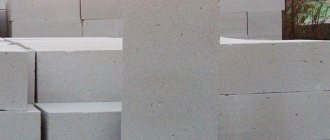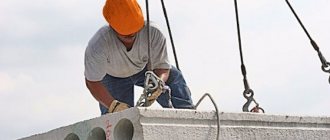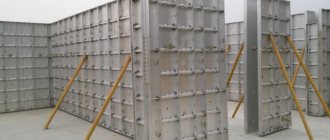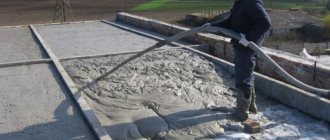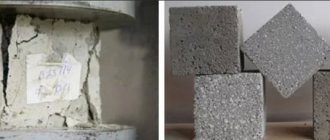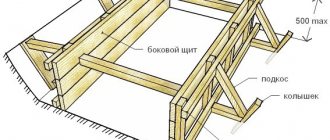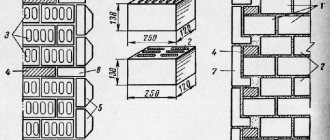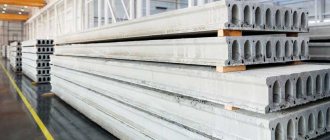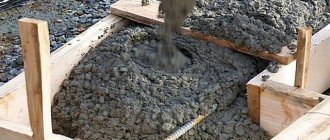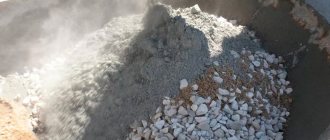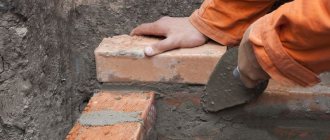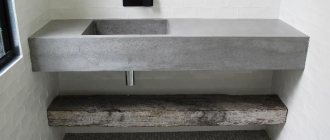Monolithic technology involves construction directly on site by pouring concrete into formwork. This technology, like any other, has its advantages and disadvantages.
So, the advantages of monolithic construction of houses:
- monolithic construction implies the integrity and unity of the entire structure, which increases the strength characteristics of the house as a whole;
- the absence of seams makes the house much warmer;
- the construction of monolithic houses can be carried out at any time of the year on various types of soil;
- savings; high speed of construction of structures;
- the possibility of erecting structures of any shape; the walls can be finished with various materials; the shrinkage of the building will be uniform, and this will eliminate the appearance of cracks.
There are also disadvantages that accompany monolithic construction:
This is ideally seeded with a concrete mixture. The strength, durability and frost resistance of concrete formwork are properties that predispose to the formation of the landscape and the design of retaining walls. More specifically, remain constant in it. The big advantage of this technology is the saving of time and money. Particularly because there is no need to remove the woodwork, and also because the preparation of the formwork often requires highly skilled carpentry or assembly work. In addition, the formwork does not remain in the structure without use, but contributes to its load-bearing function, even it can provide the building with other necessary properties, depending on what the lost formwork consists of.
pouring cement requires a concrete pump, which is quite expensive; mandatory grounding of the entire house is required, since the walls are made of reinforced concrete with conductive reinforcement.
Thus, we can say that monolithic construction is generally an excellent option for any person who decides to build a house with their own hands. This is worth talking about in more detail.
Vibration-insulated concrete or tube-type concrete fittings are most commonly used, but can also be made from insulating material. Or it can be made from cement slabs, which have the advantage of being highly variable in possible use. With their help you can create sloped walls, sloped ceilings, etc. in addition to vertical and horizontal structures, etc. a closed internal space is created from fittings or plates, which, if necessary, after applying reinforcement, are filled with concrete mixture.
Construction of a monolithic house with your own hands
However, nothing is impossible, so you can build a monolithic house yourself. The monolithic house project can be completed independently, or you can download it from the Internet or order it from a special design bureau. In any case, it will be necessary to calculate the strength of the load-bearing walls and the load on them, as well as the required thickness of the mortar and the amount of insulation.
Hollow concrete blocks filled with concrete mixtures have high load-bearing capacity, we can also use them to construct support pillars. Therefore, it is logical that it is useful to use a smart idea here and it is more logical to create a formwork, a form, only from concrete, which is due to its strength and resistance to the foundation and the ideal of underground construction. For these purposes, prefabricated thin-walled fittings are used, which are assembled dry and filled with cast concrete. At the vertical joints, they are joined by locks that fit into each other.
After the project is completely ready, you can start working on the foundation. If you plan to build a basement floor, then the foundation can be made as a strip foundation. Most often, a pile-strip foundation is erected and waterproofed. Next, we will describe the construction of a monolithic house with your own hands with removable formwork, since this option is considered the best today. You can build houses with permanent formwork.
They are profiled in such a way that they can be integrated into horizontal and vertical fittings. In addition, it is easier to measure the fundamentals, the implementation itself is less labor intensive and more accurate. The use of shuttering formwork is not limited to underground structures, but it is also possible to build perimeter walls for which we do not require high temperature resistance, such as garages or workshops.
Or we need to provide additional insulation for a load-bearing wall. They are set to “dry”; the ends of the blocks form a special locking lock into which a free piece of thermal insulation is inserted. After filling the cavity with concrete mixture, the wall forms a continuous and even base for internal and external plaster.
The formwork itself is made of boards that range in size from 30 to 50 millimeters. If the temperature in the region where construction is taking place is below -30 degrees, then it is better to choose a larger thickness of the boards.
- Metal ties with bolts are installed at the bottom. This is done so that the shields do not burst apart after pouring the solution. All panels must be secured on top with wooden overlays or the same steel ties.
- Next, depending on the project, a reinforcing mesh or frame is inserted into the formwork.
- Now you can start making sawdust concrete.
- To do this, take 8 parts of dry sawdust, one part of cement, two parts of sand and three parts of lime.
- Cement is mixed with sand.
- Separately, you need to mix lime with sawdust.
- Only after this can both mixtures be thoroughly mixed together.
- In this case, it is necessary to gradually add water to the mixture. As a result, there should be so much water that it does not flow out of the solution.
- Now the resulting solution can be poured into the formwork in a layer of 20 centimeters. The entire mixture is thoroughly mixed with a vibrator and pierced with rods to thoroughly compact the solution. After compaction, the solution is left to harden for about a day.
- Then you can fill the next layer in the same way. This is done until the formwork is almost filled.
- To simplify further work, it is worth leaving a distance of 10-15 centimeters on top. The formwork can only be moved higher after about 3-5 days. The solution must harden all this time. In this case, the formwork must be protected from the sun and rain.
- After all the walls have been erected, the concrete should be given about a month to completely harden. Only after this, further work related to the arrangement of floors and roofs is carried out. All ceilings must extend beyond the walls by at least 20 centimeters.
- When the sawdust concrete has dried completely, you can, if necessary, insulate the walls from the outside. Warm plaster, which can be applied in a layer of up to 50 millimeters, is ideal for these purposes. It is an excellent waterproofing and heat insulator, while allowing steam to pass out perfectly.
Thus, the construction of a monolithic house with your own hands can be considered complete. As you can see, there is nothing supernatural in this process. Many have long preferred to engage in this kind of construction without the involvement of third-party organizations and individuals.
We can grow our pods and fences quickly and easily. In some cases, it is not necessary to fill the cavity of the blocks with concrete, but can be filled with a dry, free-flowing mixture such as gravel. The lost formwork forms are connected to the drywall through bonding, or the structure is strengthened with horizontal or vertical reinforcement. Self-washing is carried out using a thin concrete mixture in layers, but up to three to five layers of formwork at a time.
However, if we want to improve thermal insulation, we need to add another layer of thermal insulation. A ridiculous solution is to form the formwork, mold, fitting from a material that insulates better than concrete. The material was wood waste associated with cement. We know this solution largely unchanged with us under different trade names. Walls and ceilings are concreted into prefabricated forms of wood-cement boards or fittings, which remain a permanent part of the structure after the concrete has hardened.
Reinforcement
Reinforcement is carried out with reinforcement bars, with a step whose value is not greater than that obtained by calculation. I installed additional rods in the places where the partitions were installed.
The first stage of reinforcement is to create an armored belt along all load-bearing walls, as well as along the perimeter of the ceiling. It is made from rods with a diameter of 14 mm.
It is not allowed to connect the reinforcement to each other by welding, because when heated it loses its strength. The rods must be overlapped, tightened with knitting wire. The amount of overlap must be at least 40 times the diameter of the reinforcement.
Monolithic floor formwork
To simplify the process, I drilled blind holes in the horizontal surface of the wall into which I inserted pieces of reinforcement with a diameter of 8 mm. They are also transverse (structural) reinforcement for the reinforced belt. I attached supporting rods to them.
The working fittings are laid on the flooring after it is covered with polyethylene. If there is a need to lengthen the rods, then they should be joined staggered, avoiding two joints side by side.
When installing a reinforced frame, it is necessary to ensure a gap between the reinforcement and the plane of the future floor of at least 25 mm to subsequently create a protective layer of concrete. It will prevent contact of the fittings with air and its subsequent corrosion.
To create a gap, special plastic brackets for reinforcement are used, which remain in the concrete after it hardens. They can be installed after the longitudinal load-bearing rods are connected to the transverse structural reinforcement.
Monolithic floor reinforcement
Along the edges of future openings, it is necessary to provide reinforcement not only for the lower, but also for the upper layer of concrete.
At the final stage of reinforcement, it is necessary to rigidly fasten the vertical elements of the formwork with knitting wire to the finished reinforcement frame, cover the ventilation ducts with film so that the concrete mixture does not get into them, and also install plastic pipe sleeves on the formwork in places where heating and water pipes will pass through the ceiling and sewerage. This can all be seen in the next photo.
Monolithic floor reinforcement
The reinforcement work took me about two weeks. Not much, considering that I did all this in my free time from my main job.
Do-it-yourself monolithic house construction technology
Removable formwork is always developed individually for a house or cottage. This is done due to the fact that monolithic houses can be of different shapes. The formwork must exactly follow all the outlines of the building. Most often, wood or metal is used to create formwork. You can find options that will be made of plastic or plywood. This does not change the meaning of the work.
To improve the insulating properties of the slabs or fittings, a layer of insulation, usually polystyrene, may already be added to the insulation. Thanks to the concrete core, exceptional storage capacity in the house is guaranteed, of course, high strength, fire resistance, excellent acoustic insulation and low diffusion resistance, that is, easy penetration of water vapor. As with concrete parts, the perimeter and/or interior masonry is exposed to the panels and the prepared cavity is filled with concrete.
Another possible material that formwork blocks are made from is polystyrene. Their advantage is lightness and excellent insulation capabilities. Precision interlocking blocks are simply assembled into formworks which, when sprayed with concrete, create a massive, durable structure with double-sided thermal insulation.
In this case, the width of the empty layer that is formed between the formworks should be equal to the width of the wall. This thickness depends on many different factors. The most important factors are the region of construction and the thermal conductivity of the concrete mixture.
Formwork panels are fastened with various fasteners. The optimal solution is nuts, washers and studs. To make it easier to remove the formwork after work, you need to put special corrugated tubes on the studs, which should not come into contact with the concrete.
How to choose the right building system for passive houses? What are the advantages and disadvantages of individual solutions? These are questions for the Expert Forum, a unique meeting format organized by the Passive House Center. The building system is one of the most important elements not only of passive houses, but of all houses in general. There are many materials and systems on the market. Each of them has its pros and cons, and especially features that must be observed during design and implementation. This is why Mass Building Systems was chosen as one of the Passive House Center experts that took place in Brno May.
Construction of a monolithic house involves pouring not only ordinary cement mortar, but also the possibility of using other mixtures that have lower thermal conductivity. These include: expanded clay concrete, slag concrete, sawdust concrete, and so on. All these materials have also found wide application in the construction of similar houses and cottages.
Efficient solution for massive structures for passive houses
Why did you come when you didn't?
A special feature of heavy chain structures is that they are conductive materials. Therefore, it is important to follow a few basic design principles. Sufficient and uninterrupted thermal insulation. Minimum 250 mm without weakening with support elements. . Design without thermal bridges. The structural connection parts of the external structure are thermally separated, without thermal insulation. Continuous plaster connection with other structures of sealed installation and penetration. Drawing copyright: Jiří Cech. Typical U-values for low energy and passive houses. Shown including approximate insulation thickness. These are, of course, approximate values. Achieving a passive standard house is always accompanied by comprehensive design and optimization for individual conditions.
When using one of them, you get walls that have good heat conservation and vapor permeability. However, there are also disadvantages to using such substitutes. Walls cannot withstand too much load.
A very important point is the reinforcement of the walls. For these purposes, you can use ordinary reinforcing mesh, but it is best if it is a reinforcing frame.
It is also important to remember the details and solutions of thermal bridges. They can have a major impact on the heat loss of the entire building, as well as on the quality of the internal environment and the risk of structural damage. An example of connecting a ceiling structure to a perimeter wall. Obviously, with some design systems the thermal bridging solution is seamless and eliminating thermal bridging completely is virtually impossible.
The interconnection of individual structures is also related to the non-air permeability of the entire building. This, of course, also depends on the materials used, on the suitability of their combination and on compliance with technological requirements and procedures. The combination of high-precision design, including custom parts, high-quality construction and thorough inspections results in a successful blower test completion and a quality home. The so-called pencil rule serves to simply and unambiguously define the airtight layer.
There is no need to pour more than 50 centimeters of concrete at a time. Only after the first layer has set can you continue pouring. Compaction of concrete is best done through the use of deep vibrators. Particular attention should be paid to the corners of the building.
After the concrete has hardened, the formwork must be moved higher. This is done until all the walls are built. In order for the concrete to completely harden, it needs to sit for about 4 - 5 weeks. Next comes work on insulation and finishing of the house or cottage.
Types, implementation and economics of mass building systems for passive houses
Possibilities for attaching thermal insulation
An ideal fastening is one that does not create any interruption of the thermal insulation shell and therefore no system thermal bridges.
The diagrams represent three main types of fastenings. The main advantages of this system are high load-bearing capacity, thermal bridge-free design, cost and labor savings. This fastening method can also help reduce the airtightness of the shell. However, some principles must be observed: only polystyrene or mineral wool with perpendicular fiber can be glued. Any of these materials can now be purchased without any problems in specialized construction stores. The choice of a specific one depends on the desires of the person and his financial capabilities. For those who want to save money, mineral wool is best suited, and for those who love comfort and aesthetics - polystyrene foam.
Tips for properly building passive houses
If, however, it is necessary to use mechanical anchors, it is advisable to use an anchor with the ability to install a hidden assembly in combination with thermal insulation plugs, thereby preventing the anchors from being drilled into the façade.
When designing a house, the foundation is best suited to interrupt the insulation of the house. However, it must be borne in mind that static construction is always superior, so we must take into account the individual conditions of the building's construction. Another criterion when choosing a fund is the optimization of the price of the measure. You can also use a variant of the so-called well facade. When using it, an indentation is made on the outside of a concrete wall, then everything is covered with brick or tile. After this, all free space is filled with insulation. In this case, ecowool or expanded clay can be used as insulation.
The advantage of this technology is that the monolithic house turns out to be as environmentally friendly and breathable as possible. The downside is the fuss with assembling and disassembling the formwork. For those who do not want to spend extra time on this, a technology has been created for constructing a monolithic house with permanent formwork. However, this option is not ideal either. The choice in each case will depend on the person’s preferences and his experience in construction work.
There are three main options for creating a passive house with a massive supporting structure. In order to achieve the required quality of construction and individual structures on site, it is necessary to adhere to separate technological execution rules. First of all, the correct execution of details regarding the functions of waterproofing, thermal insulation, static, airtightness, as well as on-site coordination.
In particular, when doing masonry. However, when calculating, it is always necessary to evaluate the complexity, complexity of execution, complexity of structural parts and associated structures, or increased requirements for execution accuracy. The additional cost to achieve a passive standard is about 5-10% compared to today's construction. These additional costs are now covered by the New Green Savings Grant Programme.
Monolithic slab foundation
The foundation in the form of a monolithic slab is excellent for the construction of residential and commercial buildings on problematic soils. This type of structure is characterized by high load-bearing capacity, seismic resistance, it cannot be washed away by groundwater, and the slab foundation is also a subfloor.
The last factor allows you to save on wooden logs for flooring and antiseptics for their treatment. For the construction of a two-story house, a slab 40 cm thick will be sufficient.
The technology for building a foundation of this type is simple and can be implemented on your own. The main stages of constructing a 40 cm thick slab foundation:
- Digging a pit 0.6 meters deep, planning the bottom of the pit.
- Filling a layer of sand bed 20 cm thick, tamping.
- Filling with a layer of crushed stone 20 cm thick, tamping.
- Production of formwork. Shields are made from edged boards 25 mm thick. The width of the shield should be 20 cm. In this case, when pouring the foundation, a size of 20 cm will provide the required thickness of the slab. The outer surface of the shields is reinforced with bars.
- Installation of formwork. When installing the formwork, ensure that the top cut of the panel is horizontal. This will make it possible to use the upper cut of the shields as a beacon for the upper surface of the slab. Horizontal alignment can be ensured by adding soil, laying pieces of brick, laying wooden blocks and checking the building level.
- Installation of reinforcement. “Factory” construction reinforcement with a diameter of 12 mm should be used. Important! The reinforcing belt for a slab foundation is assembled using knitting wire and in no case by welding.
- Pouring concrete. A very important stage. One of the main questions is the required amount of concrete for a monolithic slab foundation. The answer to this question will be given by a special concrete calculator for a monolithic slab foundation, which can be found on the Internet. At the same time, the required volume of building material can be calculated by simple arithmetic. We multiply the length, width and height of the slab in linear meters, we get the amount of concrete in cubic meters. The best brand of concrete for a monolithic foundation is heavy concrete M200 or M250.
- Ironing the surface of the slab and covering the structure with plastic film.
- Dismantling of the formwork no earlier and no later than 7-10 days.
The pouring of a monolithic slab should be done as quickly as possible, otherwise the principle of “solidity” will be violated. This will significantly worsen the bearing capacity of the foundation and negate its advantages.
The best option is to calculate the theoretical consumption of concrete, increase it by 10% (multiply the theoretical consumption in cubic meters by 1.1) and order ready-made building material from a concrete plant. If it is impossible to buy ready-made material, you need to be prepared to produce concrete on your own around the clock.
DIY monolithic house video
Concrete is a building material consisting of crushed stone, sand, water and cement. Preparing concrete involves thoroughly mixing the ingredients and pouring it into containers, where the concrete solution subsequently hardens. To build a warm house, special fillers are added to the mixture to improve the quality of concrete. Concrete composition for building houses has many advantages, one of them is the ability to prepare a solution and build a structure with your own hands.
Presentation of individual systems presented at the Expert Forum
This is the most commonly used solid construction. High thermal conductivity - the need to separate thermal bridges of a thin design of installation lines. Utor: Jiri Cech, Michal Hucik.
Precast Precast Concrete Panels
Availability – The need for local concrete plant solutions requires external support.
Author: Jiri Cech, Juraj Hazuha. Compliance with passive house requirements. Due to its features, this system is primarily intended for use in energy-efficient buildings. Candidates can choose from three main options. Optimal wall structure allowing for variability of insulating parts. Attaching non-supporting parts with removable plastic partitions creates wasted formwork.
When working with a concrete house, the following advantages are distinguished:
- speed of installation;
- reliability;
- longevity;
- high strength of the structure;
- relatively low financial costs;
- in a monolithic house there are no gaps through which the cold passes;
- soundproofing the room;
- the possibility of using any finishing material on top of concrete;
- the possibility of constructing buildings with your own hands;
- concrete has various geometric shapes, which simplifies the installation process;
- when pouring the solution evenly, the formation of cracks is reduced;
- the use of light mixtures in the composition does not require deepening the foundation.
DIY concrete houses have the following disadvantages:
Subsequent filling of the concrete mixture results in a monolithic reinforced concrete core. After the concrete has hardened, the wall is ready for surface treatment. Greater insulation capabilities of thermal insulation distribution due to reduced fire load on the outside. Wall-mounted lost formwork system made of thermal insulation of non-supported and cement-fiber boards. Optimal wall structure ensuring accumulation in the concrete core of the wall. By connecting non-supporting parts and cement fiber boards using removable plastic partitions, lost formwork is created.
- the need for additional equipment when working at height;
- due to the metal reinforcement of the walls, the house will need grounding;
- when using permanent formwork, it is necessary to ensure ventilation of the room so that the house can breathe;
- welding the frame will require a lot of labor, which is also needed if possible;
- a warm house can only be built after proper insulation;
- if the design includes permanent formwork, polystyrene is used, and when burned it releases toxic substances that are harmful to human health.
Varieties of monolith
If initially monolithic houses were only made of reinforced concrete, today there are variations on the theme - instead of DSP they use wood concrete or sawdust concrete, and instead of a reinforcement frame they use wooden racks.
But the essence remains the same - enclosing structures are not assembled or laid out from individual elements, but rather are poured. As a result, monolithic, seamless walls of almost any geometric shape are formed, which frees up the hands of architects. That is, if the abundance of bay windows and arches during construction from block/brick/wood significantly complicates the process, then no special effort will be required when pouring.
Since ordinary reinforced concrete turns out to be too cold, due to its high thermal conductivity and thin walls, foam concrete, polystyrene concrete or expanded clay concrete are used to do without additional insulation. In the first case, the thermal conductivity of the wall is reduced due to the formation of a large number of air pores in the concrete due to foam, in the second - due to the addition of polystyrene or expanded clay granules. But according to its varieties, the monolith is divided not by the type of concrete poured, but by the type of formwork - it can be removable or permanent.
Removable formwork
In the private sector, it is usually made of moisture-resistant or laminated plywood; boards, metal or plastic are less commonly used. The sheets are used whole or cut into pieces, depending on the scale of the fill. The elements are fastened together and, as they are poured, moved to a new location, since only specialized companies can afford to assemble the formwork for the entire house at once. And self-builders fill houses in stages, mainly horizontally. Plywood is deservedly popular, as it holds its shape well and allows you to get a smooth wall surface, and if it is also laminated, then the set can be enough for more than one construction site. As for fasteners, everything is individual.
alexxxxx
Plywood 12 mm thick, increased moisture resistance, 2500 × 1200 mm, cut in half along the length (600 mm), four ties per sheet (sheets were drilled through, folded together, 100 mm from the bottom), the top was tied together with bars. Ties with two jammed nuts at one end, 250 mm long, 8 mm in diameter, were lowered into the spindle. Drive-in nuts are driven into the formwork from the outside; you only need to turn it (with a screwdriver) from inside the walls.
Rearranging removable formwork as it is poured is considered one of the most labor-intensive and time-consuming processes, and the fewer operations required, the better.
Permanent formwork
Unlike the removable one, intended solely to give the filler the desired shape and dismantled after setting, the non-removable one remains in the “pie” and at the same time serves as insulation. These are hollow blocks or slabs with composite lintels, smooth edges or a grooved connection system. Permanent formwork can be either entirely made of polystyrene foam, or combined - EPS as the outer wall, and the inner one is made of slab materials. There are also technologies for permanent formwork, where EPS is used only as insulation, and both walls are made of pressed wood chips. Such blocks are considered more environmentally friendly than polystyrene ones.
sasha_nik
I will note the main advantages and disadvantages of this type of permanent formwork, in my opinion, from the point of view of not a professional, but a consumer.
Advantages:
- Saving house space - wall thickness 32 cm.
- In terms of cost and speed of construction, it is no more expensive than, say, aerated concrete, 400 mm thick with insulation.
- The wall is monolithic - the most durable, in theory, the likelihood of its destruction, i.e., the formation of cracks, if the technology is followed, is practically excluded.
- The interior of the house is made of chip-cement slabs - the microclimate will be close to the microclimate of a wooden house.
- It is easy to screw screws into the inner wall, and it is easy to make grooves for electrical wiring.
Flaws:
- Expanded polystyrene as insulation is a dubious drawback, taking into account the fact that, using EPS technology, it will be protected from external influences by non-combustible materials. Whether it will fall apart in thirty years is also debatable and largely depends on the quality of the PPS itself and on the quality of work performed during construction. But this is the only thing that confuses me about this technology. Although many insulation systems are also based on polystyrene foam.
- The facade is made of a chip-cement slab - this drawback can be easily eliminated with a protective curtain screen, decorative plaster or another method.
The thickness of the heat insulation layer is selected depending on the region of construction, it starts from 50 mm, but on average 100 mm is enough if we are not talking about the northern regions. You can find out the exact figure by making a heat calculation, and based on the results, select suitable blocks or slabs.
Tools and materials for work
When constructing buildings and structures made of concrete, you cannot do without the following tools and equipment:
- mixer for connecting concrete components;
- containers for mixing concrete mixture with your own hands;
- reinforcement;
- trolley for transferring solution;
- construction hair dryer;
- perforator;
- knife for cutting foam;
- various tools;
- wire cutters;
- roulette;
- wire;
- hammer;
- sand;
- fittings;
- cement;
- concrete mixer;
- crushed stone;
- formwork
Homemade concrete retaining wall
If the slope of the surface of your site is not too large, then making a concrete retaining wall with your own hands will not be difficult. For example: you need to build a retaining wall 1.2 m high (above ground level). In order to save building material (rebar and concrete mortar), we recommend choosing a thin-walled corner retaining wall with a T-shaped base. How to make a concrete retaining wall (three main steps):
Preparatory stage
First we prepare a sketch, drawing and reinforcement diagram.
Then we begin land work. We make markings using pegs and construction cord. We dig a trench of the required width (slightly larger than the width of the support, taking into account the formwork) and depth (taking into account the thickness of the support and the cushion of sand and crushed stone). We store the earth from the trench in a free area (later it will be needed for backfilling on both sides of the wall). We pour sand into the bottom of the trench (the thickness of the layer is about 0.2 m) and tamp it down (wetting it periodically with water). Then we fill in the same layer of crushed stone and also compact it (with a vibrating plate or a hand tamper). We lay geofabric on top of the equipped pillow.
Formwork and grouting
Now let's start creating the reinforcing frame. The reinforcing bars of the “sole” and “body” of the wall must be connected to each other.
We are building formwork. First we do it only for the foundation of the wall. After this, we pour concrete mortar along the entire length of the foundation and compact it using a vibrator. After the mortar has set, we proceed to installing the formwork of the supporting wall itself. The manufacturing technology of formwork and the materials used for its manufacture are similar to the arrangement of a strip foundation.
Important! In the process of arranging the formwork, it is necessary to lay transverse plastic or asbestos-cement pipes into it to drain groundwater and precipitation penetrating into the soil (the lower edge of the pipes should be slightly above the ground level on the outside of the supporting wall). This will significantly reduce the load on the inside of the vertical slab. The distance between transverse drainage pipes is 1.0÷1.5 m.
Then we begin pouring the concrete retaining wall.
Attention! To prevent the formwork from collapsing or deforming during pouring, it is better to carry out this process in stages. First, fill the solution to ⅓ of the height along the entire length of the wall. Then we vibrate the poured solution. Next, fill the formwork with the solution another third, and so on.
To ensure maximum strength and uniformity, it is advisable to fill the entire structure in one day. After the solution is poured to the upper edge of the wall and completely compacted, the surface is leveled and covered with plastic wrap and left for final drying. To prevent rapid evaporation of water from the solution (which can negatively affect strength), in hot weather the surface of the solution is periodically wetted.
Waterproofing and arrangement of drainage system
After 7–9 days, we begin dismantling the formwork. To ensure durability, concrete wall surfaces are covered with a waterproofing material (for example, a special composition based on liquid rubber).
Next, we proceed to arranging a drainage system for a concrete retaining wall using the following technology:
- Along the entire length of the wall from the inside (that is, from the side of the slope), we lay a perforated pipe (necessarily wrapped in water-permeable geofabric).
- Then we fill this pipe with crushed stone.
- We lay geotextiles on top of the crushed stone (to preserve the free space not filled with soil between the individual particles of crushed stone).
- We take the free end of the pipe (on one or both sides of the wall) into a drainage ditch (or well) or the nearest drainage basin.
At the final stage, fill the free space around the wall with soil.
Important! We begin backfilling the soil only after the concrete retaining wall has gained its final strength and can withstand significant loads from the slope, that is, no earlier than in a month.
Next, we proceed to decorating the visible part of the constructed retaining wall. For these purposes, facing tiles, natural or artificial stone are usually used.
Construction methods
The construction of concrete houses occurs in two ways: using removable formwork and non-removable formwork. The removable method involves individual planning of formwork, the purpose of which is to accurately replicate the contours of the future structure. Removable formwork is made of plastic, metal or wood. This method pours concrete mortar with minimal heat transfer, which allows heat energy to be retained in the room. The non-removable method makes the walls thin, but at the same time retains all its structural properties.
This formwork has a thermal insulation layer and built-in reinforcement.
Composition of monolithic concrete
In general, all the main structures of a low-rise building made of monolithic concrete (foundation, floor slabs and walls) are constructed from heavy concrete grades M200, M250 or M300. The choice of brand depends on the height of the groundwater and climatic conditions in the area where the future structure is located.
The practice of monolithic construction shows that the “golden mean” is heavy concrete grade M200, consisting of Portland cement TsEM I 32.5N PC (M400) or TsEM I 42.5N PC (M500), quarry sand, granite crushed stone with a particle fraction of 10- 20 mm and water. Depending on the pouring conditions, antifreeze, hydraulic and strength additives, setting accelerators and a plasticizer are added to the concrete.
Proportions for concrete grades for monolithic construction and consumption for preparing 1 m3 of material. Table.
| Concrete, brand | Proportions of components, C:P:SH:H, kg | Component consumption per 1 m3, kg | |||
| Cement M400 | Sand | Crushed stone | Water | ||
| M200 | 1:3:4,5:0,7 | 255 | 715 | 1125 | 190 |
| M250 | 1:2,3:3,8:0,6 | 295 | 690 | 1115 | |
| M300 | 1:2:3,3:0,6 | 335 | 670 | 1105 | |
| Concrete, brand | Proportions of components, C:P:SH:H, kg | Component consumption per 1 m3, kg | |||
| Cement M500 | Sand | Crushed stone | Water | ||
| M200 | 1:3,3:5:0,8 | 225 | 735 | 1125 | 190 |
| M250 | 1:2,8:4,3:0,7 | 255 | 720 | 1115 | |
| M300 | 1:2,5:3,8:0,7 | 290 | 705 | 1105 | |
With permanent formwork
Permanent formwork for the foundation.
The permanent formwork method has the following types of construction: corner, longitudinal, above the window, under the window. This method of wall construction has an internal layer of thermal insulation, which allows you to save on heating costs. It simplifies the installation of the structure due to its lightness and creates various room configurations.
Thermal insulation of the material is especially important for buildings and structures, because its absence requires the construction of walls of great thickness. The disadvantages include the formation of danger as a result of the release of toxins into the atmosphere, which appear during a fire in buildings.
Construction technology
The formwork is placed on a layer of waterproofing and fastened into grooves; this technology creates a strong pouring of concrete mortar, as a result of which there is no leakage of the mixture at the joints. When pouring the formwork, it is prohibited to use heated solutions; they can form condensation in large quantities, which will increase the humidity of the room. By using permanent formwork, the house is provided with a good layer of thermal insulation, which only requires covering the polystyrene foam boards with facing material.
Walls of multi-storey buildings made of monolithic polystyrene concrete
There are different types of this material, which differ in properties and price. However, the quality of even the cheapest brick remains quite high, as do its strength characteristics. Next, we will consider what the thickness of a brick wall should be when constructing certain objects, as well as some technologies for constructing brick walls.
In order for buildings to be strong and reliable, before starting construction it is important to take into account a number of factors in the project:
Advantages
The thickness is usually regulated by state standards. During construction, it is very important that the walls comply with GOST.
At the moment, the construction of facilities is regulated by the following standards: GOST R Masonry and products for it and GOST 2 Method for determining the adhesion strength in masonry.
At the moment, the thickness can be within 0.64 m. This type of masonry is used for the construction of small fences when delimiting a site and interior partitions.
The masonry of 1 brick has a thickness of 0.25 m. It is often used in the construction of fences, fences, sheds and other auxiliary buildings. The construction of 1.5-layer brick walls is quite common in the southern regions of the country. In some old series of panel houses there are load-bearing panels mm thick. Thus, if the thickness of the measured wall is less than mm. It should be noted that the finishing layers of walls, plaster and wallpaper, can make adjustments to its thickness, but in panel houses they usually do not exceed 50mm.
The thickness of the walls in brick houses is a multiple of the brick size mm. Thus, brick walls can have the following thicknesses: ,,,,mm. Load-bearing walls in brick houses have a thickness of mm.
With removable
Using removable formwork, methods for its insulation are chosen. One option is to insulate the gap with warm plaster; the second method is a well façade. The well facade is a monolithic wall facing with brick, and the gap between them is sealed with insulation. The well facade is the optimal solution for insulation, which provides the walls with breathable qualities. Thus, the house is resistant to overheating in the summer and will keep the room cool, and in the cold season it will keep warm and resist freezing.
Construction technology
The technological process consists of pouring formwork in several stages. Begin laying the solution no more than 50 centimeters of concrete.
Leave the mixture to dry, the next layer is applied after the previous one has completely hardened. After pouring the solution, it is compacted using a deep vibrator. Next, move the mold up after the solution has completely hardened.
The concrete mixture is laid until the required wall height is reached. To make the structure strong, reinforcing mesh is installed in the walls. The finishing of the walls and installation of thermal insulation material is carried out one and a half months after laying the concrete solution, waiting for the final strength of the structure. Thermal insulation material can be:
- Styrofoam;
- mineral wool;
- warm plaster;
- extruded polystyrene.
The removable form is made of wood, metal or plastic. When using a plywood sheet, it is cut with a fine-toothed file and drilled on both sides; this method prevents destruction of the coating. When plywood is stored at the bottom of the formwork, it is protected from moisture penetration onto its surface. To ensure that disassembling the formwork does not cause difficulties, the plywood is coated with a special mixture and fasteners are fixed to it.
General information
Before deciding to build a concrete house, you should familiarize yourself with all the advantages and disadvantages of such construction:
Advantages
Among the advantages of concrete buildings, the following points can be highlighted.
- A concrete house is a monolithic structure
, due to which it has good mechanical strength and also withstands seismic activity. - Construction can be done on any soil
. - Concrete houses are built quickly
. - Construction cost is relatively low
. - It is possible to build a house of any configuration
. - Concrete walls can be finished with any materials
. - Possibility of a slab as a floor
. - Concrete new building shrinks evenly
.
Flaws
Of course, there are also disadvantages of such construction, however, there are not very many of them:
- Requires certain equipment, such as a concrete mixer and an internal vibrator. If the house is being built on several floors, then a concrete pump will also be required.
- When constructing a monolithic floor, labor costs increase, since it is necessary to perform formwork and reinforcement.
- Concrete has a fairly high level of thermal conductivity, so the walls must be insulated before finishing.
